Are you considering upgrading to the Shimano 105 Di2, or its SRAM equivalent, the Rival eTap AXS?
After spending hours sifting through all the technical and product documentation, I compared the features, specifications, and key differences between the Shimano 105 Di2 and the SRAM Rival eTap AXS. This article aims to provide you with all the necessary information to make the best choice for your needs.
Each groupset has its pros and cons, and your decision may ultimately come down to personal preferences, budget, or availability.
Key takeaways
The Shimano 105 Di2 and SRAM Rival eTap AXS are entry-level, 12-speed electronic shifting groupsets. Both offer great value for money while inheriting all the important features of the mid to top-of-the-line groupsets.
- Shimano 105 Di2 was launched in June 2022. It’s the first electronic groupset for the 105 series and features a semi-wireless shifting mode, a redesigned brake hood, and an extra 10% brake pad clearance.
- SRAM Rival eTap AXS is a fully wireless groupset launched in April 2021. It has a wider gear ratio and an optional power meter crankset.
The table below shows a high-level comparison between the Shimano 105 Di2 and SRAM Rival eTap AXS. The following sections detail the breakdown and comparison of each groupset component.
| Comparison | Shimano 105 Di2 (R7170) | SRAM Rival eTap AXS |
|---|---|---|
| Launched | June 2022 | April 2021 |
| Total weight | 2,990 to 3,100g | 3,100 to 3,200g |
| Shifting | Semi-wireless | Full wireless |
| Disc brakes | Yes | Yes |
| Rim brakes | No | No |
| Pricing | $1,900 to $2,000 | $1,400 to $1,600 |
Brake levers and shifters
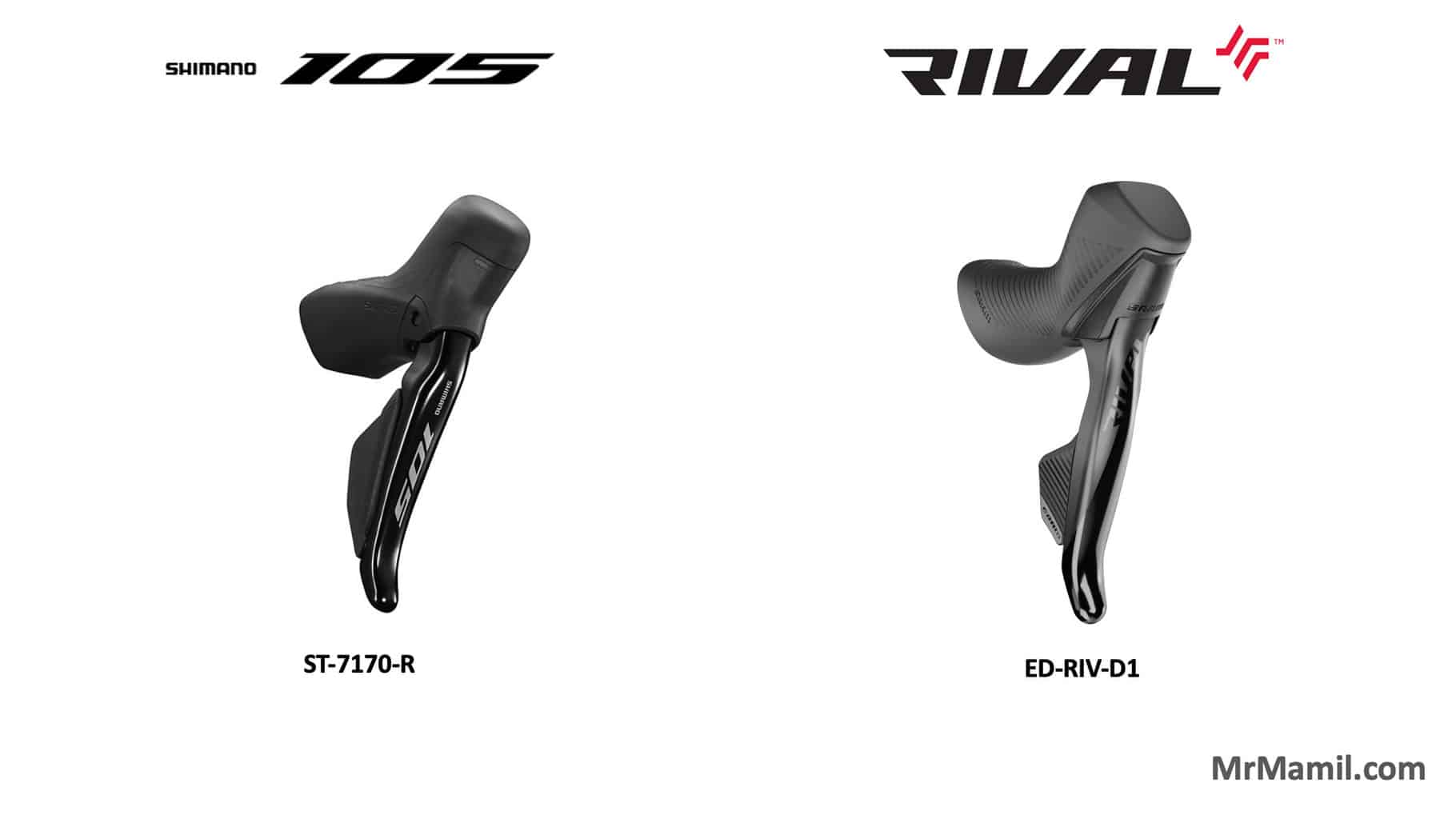
| Comparison | Shimano 105 Di2 | SRAM Rival eTap AXS |
|---|---|---|
| Model no. | ST-R7170-R/L | ED-RIV-D1 |
| Disc brake | Available | Available |
| Rim brake | Not available | Not available |
| Batteries (each lever) | 2x CR1632 | CR2032 |
| Lever material | Alloy | Alloy |
| Hood button | No | No |
| Cable ports | 1 | 0 |
| Brake caliper mount | Flat mount | Flat mount |
| Weight (each lever) | 387g | 425g |
| Price (USD) | $405 | $387 |
| Where to buy | Amazon Competitive Cyclist Wiggle | Amazon Competitive Cyclist Wiggle |
The Shimano 105 Di2 brake levers and shifters are completely redesigned compared to its predecessor (R7000). They have the same design and ergonomics as the Dura-Ace R9200 and Ultegra R8170. Each Shimano brake lever uses two CR1632 batteries, which Shimano claims to last up to 4 years of use. Unlike the Dura-Ace and Ultegra shifters, the hood has no third button.
The SRAM Rival eTap AXS brake levers and shifters use a single CR1632 battery and have a different hood design than the Force and Red eTap AXS. It has a narrower grip, lower profile, and slimmer design. There are no cable ports for Blip shifters.
Similarities
- Wireless shifting. Shimano 105 can be configured wireless or wired (requires additional cables and Junction A). SRAM Rival eTap AXS is a fully wireless setup.
- Material. Both brake levers are made of alloy, and shifter buttons are made of plastic.
- Coin battery powered. Shimano 105 requires 2x CR1632 batteries, while SRAM Rival eTap AXS requires a single CR2032 battery per lever.
- Cable port. Shimano 105 has a single cable port for sprint shifters (Shimano), while SRAM Rival eTap AXS has none.
- Lever reach adjustment is supported by Both Shimano 105 and SRAM Rival eTap AXS. This refers to the distance between the drop bar grip and the brake lever.
Differences
- Shift buttons. There are two shift buttons on the Shimano 105 levers compared to one on SRAM Rival eTap AXS. The buttons are fully customizable through the Shimano E-Tube App or SRAM AXS mobile app.
- Weight. Shimano 105 is around 38g lighter (levers, brake caliper, brake hose).
- Free stroke adjustment is only available in Shimano 105. This refers to the point in the brake levers’ stroke where the brake pads come into contact with the rotor. SRAM refers to this as the Contact Point Adjustment and is only available in Force and Red eTap AXS.
- Tactile feel. The Shimano shift buttons feel lighter compared to the more tactile SRAM buttons.
Rear derailleurs (RD)
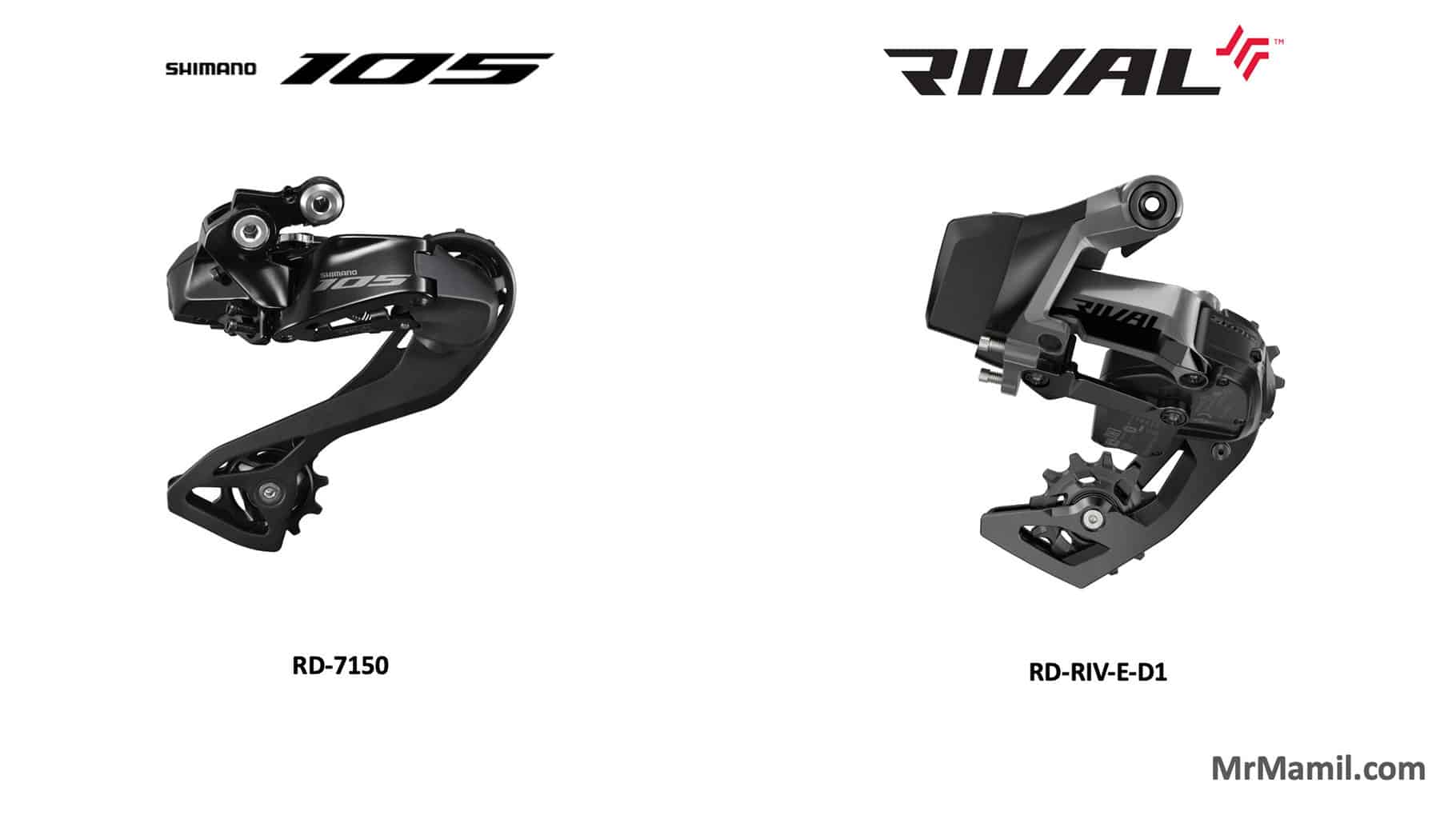
| Comparison | Shimano 105 Di2 | SRAM Rival eTap AXS |
|---|---|---|
| Model no. | RD-R7150 | RD-RIV-E-D1 |
| Weight | 300g | 354g |
| Max. cog size | 36T | 36T |
| Cage material | Aluminum | Aluminum |
| Pulley bearings | Steel | Steel |
| Price (USD) | $280 | $481 |
| Where to buy | Competitive Cyclist | Amazon Competitive Cyclist Wiggle |
The Shimano 105 rear derailleur sport the same design as the Ultegra and Dura-Ace models. It features the Shimano Shadow design, which places the rear derailleur in a low-profile design that provides aerodynamic benefits and lessens the chances of damage in a crash. The Shimano rear derailleur also acts as the hub of the Di2 system. It holds the charging port, LED indicators, and function button.
The SRAM Rival eTap AXS rear derailleur is noticeably bigger as it needs to accommodate the battery.
Similarities
- Long cage. The rear derailleurs can be considered long cages and support a maximum cog size of 36T.
- Cage material. Both rear derailleur cages are made from aluminum with steel pulley wheel bearings.
Differences
- 1X compatibility is supported by the SRAM Rival eTap AXS.
- Weight. The SRAM Rival eTap AXS rear derailleur is significantly heavier (+54g) than the Shimano 105. This is mainly due to the battery, which weighs 26g.
More reading : How to Get the Most Out of Shimano Di2 Features
Front derailleurs (FD)
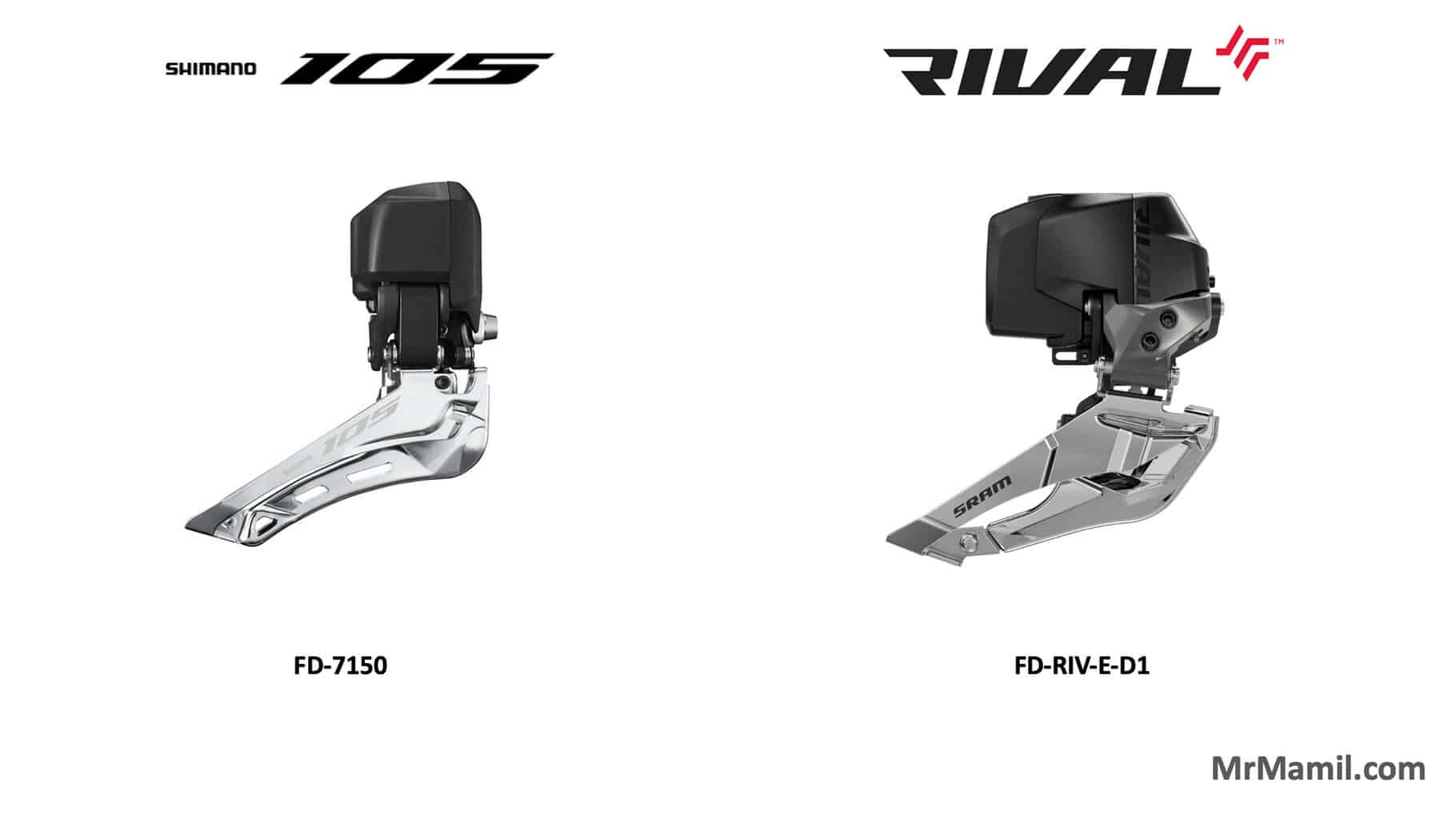
| Comparison | Shimano 105 Di2 | SRAM Rival eTap AXS |
|---|---|---|
| Model no. | FD-R7150 | FD-RIV-E-D1 |
| Weight | 138g | 177g |
| Price (USD) | $153 | $335 |
| Where to buy | Amazon Competitive Cyclist | Amazon Competitive Cyclist Wiggle |
Shimano has completely redesigned the front derailleur to be lower profile and slimmer.
The SRAM Rival eTap AXS front derailleur is noticeably bigger as it needs to accommodate the battery. It’s heavier (+39g) than the Shimano 105. This is mainly due to the battery, which weighs 24g.
Cranksets
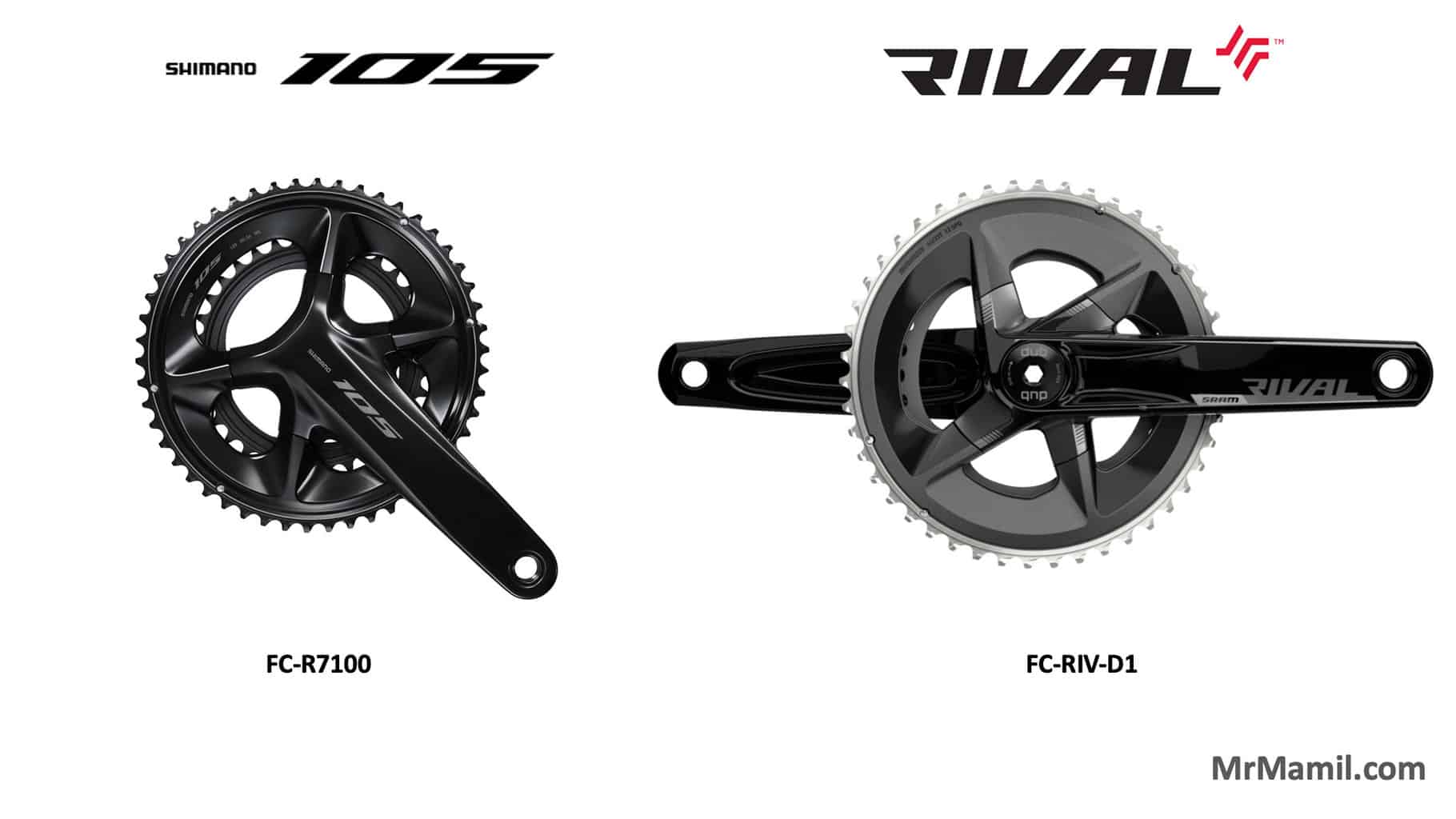
| Comparison | Shimano 105 Di2 | SRAM Rival eTap AXS |
|---|---|---|
| Model no. | FC-R7100 | FC-RIV-D1 |
| Chainring options | 50-34T, 52-36T | 46/33T, 48/35T |
| BCD | 110mm | 107mm |
| Crankarm material | Aluminum | Aluminum |
| Crankarm lengths | 160, 165, 170, 172.5, 175mm | 160, 165, 170, 172.5, 175mm |
| Axle diameter | 24mm | 29mm |
| Chainline | 44.5mm | 45, 47.5mm (wide) |
| Powermeter | No | Optional |
| Weight | 760g (50/34) | 844g (46/33) |
| Price (USD) | $180 | $241 |
| Where to buy | Amazon Competitive Cyclist | Amazon |
Shimano stuck with the traditional compact (50/34T) and semi-compact (52/36T) when they moved to 12s. Remember that the Shimano 11s chainrings are incompatible with the 12s crankset, although they have the same BCD. The difference lies in the placement of the four arms.
On the other hand, SRAM introduced the X-Range Gearing for its 12s groupsets. The SRAM Rival eTap AXS cranksets are available in a 46/33T or 48/35T combination. There is also a power meter version available.
Similarities
- Crankarm lengths. Both crankarms are available in 160, 165, 170, 172.5, 175mm lengths. The 170 and 172.5mm are the most commonly used length, and 160 and 165mm could be harder to source.
- Crankarm material. Both are made from aluminum.
Differences
- Chainring combination. The Shimano 105 is available in 50/34T (compact) and 52-36T (semi-compact). The chainring sizes for SRAM Rival eTap AXS are slightly smaller at 46/33T or 48/35T as it uses a 10T smallest cog.
- BCD. While both cranksets use a 4-arm design, the Shimano 105 has a 110mm BCD, and SRAM Rival eTap AXS has a 107mm BCD.
- Bottom bracket compatibility. Shimano 105 uses a 24mm steel axle. SRAM Rival uses a 107mm steel axle and is only compatible with SRAM DUB bottom brackets.
- Power meter. The SRAM Rival eTap AXS has an option for a power meter unit, which adds around 40g to the total crankset weight. It’s powered by a single AAA battery.
- Wide chain line. SRAM Rival eTap AXS has a wide version, which caters to bikes using wider tires up to 700x45c.
More reading : How to Decide Between Compact vs Standard Crankset
Shimano vs SRAM gear ratios
The gear ratios are among the most significant differences between the Shimano and SRAM.
SRAM’s X-Range Gearing generally has a wider gearing range and tighter jumps between cogs than Shimano. This makes maintaining the same cadence more versatile and easier after a gear shift.
The table below shows the possible gearing setup for Shimano and SRAM.
- High gear. SRAM has the highest gear ratio at 4.8 using a 48/35T front chainring and 10T rear cog, followed by Shimano (4.73) with a 52/36T front chainring and an 11T rear cog.
- Low gear. SRAM has the lowest gear ratio at 0.92 using a 46/33T front chainring and 36T rear cog, followed by Shimano (0.94) with a 50/34T front chainring and a 36T rear cog.
| Front | Rear | Shimano gear ratio | SRAM gear ratio |
|---|---|---|---|
| 50 | 11 | 4.55 | |
| 34 | 36 | 0.94 | |
| 52 | 11 | 4.73 | |
| 36 | 36 | 1.00 | |
| 46 | 10 | 4.60 | |
| 33 | 30 | 1.10 | |
| 33 | 36 | 0.92 | |
| 48 | 10 | 4.80 | |
| 35 | 30 | 1.17 | |
| 35 | 36 | 0.97 | |
| 50 | 11 | 4.55 | |
| 34 | 34 | 1.00 | |
| 52 | 11 | 4.73 | |
| 36 | 34 | 1.06 |
More reading : Bicycle Gearing Explained
Groupsets comparison
Chains
| Comparison | Shimano 105 Di2 | SRAM Rival eTap AXS |
|---|---|---|
| Model | CN-M7100 | CN-RIV-D1 |
| Links | 116, 126 | 120 |
| Weight | 254g (116 links) | 266g |
| Material | Steel | Steel |
| Outer plates finish | Gray | Nickel |
| Inner plates finish | Sil-Tec | Nickel |
| Pin design | Solid | Solid |
| Price (USD) | $43 | $40 |
| Where to buy | Amazon Competitive Cyclist Wiggle | Amazon |
Shimano and SRAM chains are steel and use a solid pin design.
The Shimano 105 chains are available in 116 and 126 links. Sil-Tec treatment is applied to the inner plates for added durability. It’s the same chain as the Shimano SLX mountain bike range.
The SRAM Rival eTap AXS chains are available in only 120 links and have a nickel inner and outer plate finish. It uses a Flattop design which, according to SRAM, is quieter and more durable.
More reading : When to Replace A Bike Chain?
Cassettes
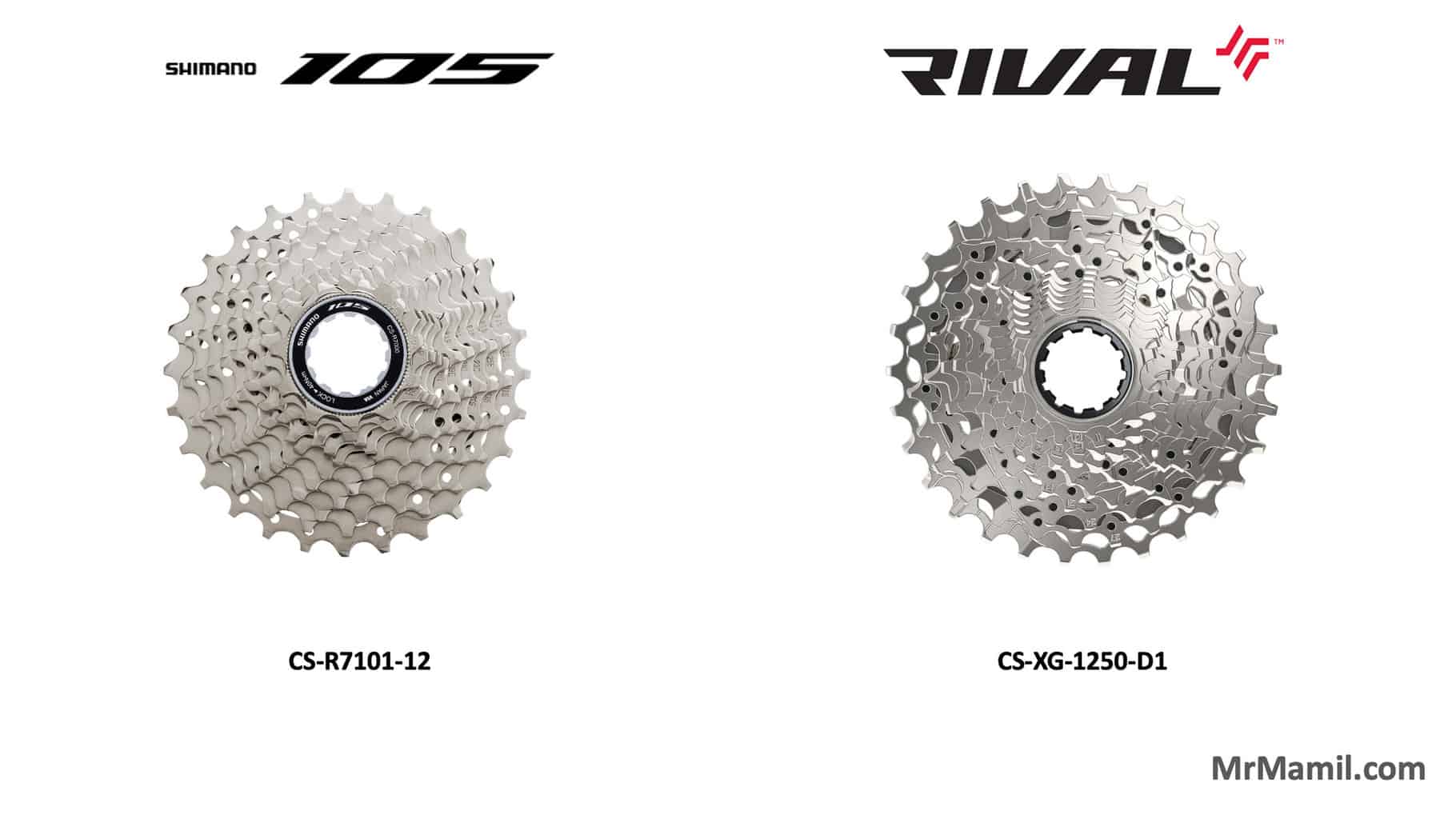
| Comparison | Shimano 105 Di2 | SRAM Rival eTap AXS |
|---|---|---|
| Model | CS-R7101-12 | CS-XG-1250-D1 |
| Size | 11-34T | 10-30T, 10-36T |
| Weight | 361g | 283g, 338g |
| Price | $66 | $132 |
| Where to buy | Amazon Wiggle | Amazon Competitive Cyclist Wiggle |
The Shimano 105 cassette is officially available in 11-34T. However, a non-105 series cassette (CS-HG710-12) in 11-36T is compatible.
The Shimano 105 cassette uses the older Hyperglide (HG) technology vs the newer Hyperglide+ (HG+) on the Ultegra.
- Hyperglide+ (HG+) is a specific cog tooth profile to match the chain for faster shifting, both up and down the cassette, especially under load.
- Hyperglide (HG) is similar, but only for shifting to a larger cog.
The SRAM Rival eTap AXS cassette is available in two sizes; 10-30T and 10-36T. The cassette consists of a single block of 12 cogs held together by 123 stainless steel pins.
More reading : SRAM Rival vs Force vs Red AXS Cassettes
Disc brake rotors
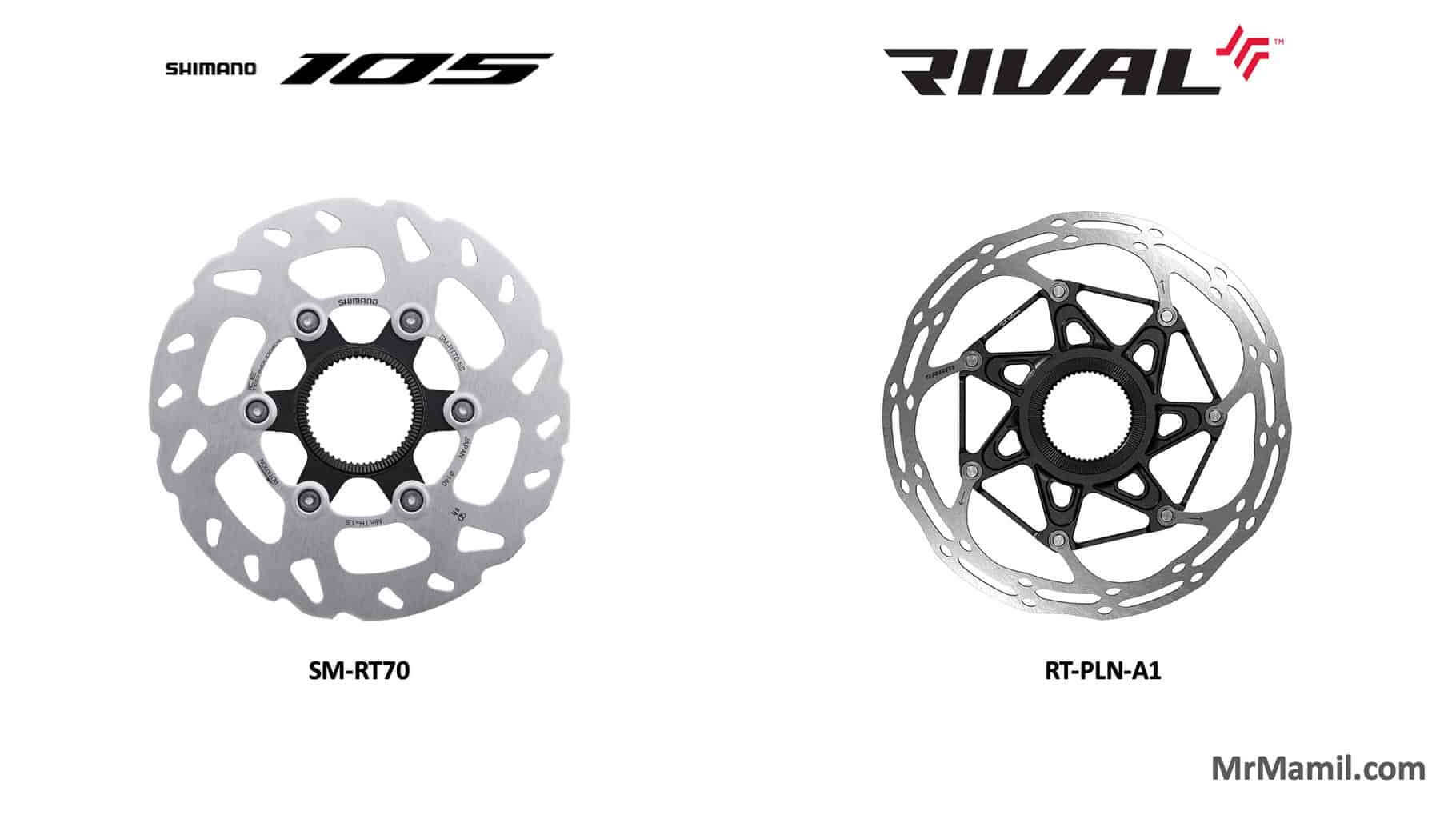
| Comparison | Shimano 105 | SRAM Paceline | SRAM Centerline |
|---|---|---|---|
| Model no. | SM-RT70 | RT-PLN-A1 | RT-CLX-R-A1 |
| Mount type | Centerlock | Centerlock, 6-bolt | Centerlock, 6-bolt |
| Weight (140mm) | 121g | 137g | 108g |
| Weight (160mm) | 133g | 157g | 135g |
| Price (USD) | $46 | $54 | $113 |
| Where to buy | Amazon Competitive Cyclist | Amazon Wiggle | Amazon Competitive Cyclist Wiggle |
Shimano 105 and SRAM Rival rotors are available in 140mm and 160mm sizes.
Shimano used the same brake rotors from their mountain bike lineup, the RT-CL800 (Ultegra) and SM-RT70 (105). Both rotors are available in 140mm and 160mm sizes.
The difference between the 105 and Ultegra rotors lies in their design and cooling technologies.
SRAM offers two rotor choices;
- Paceline. Cheaper but heavier.
- Centerline. Lighter but 2x more expensive.
Both Paceline and Centerline rotors are available in either Centerlock or 6-bolt. Shimano rotors are only Centerlock.
More reading : Centerlock vs 6-bolt Disc Brake Rotors
Disc brake pads
The Shimano 105 comes with Shimano’s latest, fifth-generation organic (resin) brake pads, L05A-RF. Older models such as L03A-RF (organic), L02A-RF (organic), or L04C-MF (metallic) are compatible with the disc brake calipers as they all have the same shape.
The SRAM Rival eTap AXS comes with an organic brake pad with steel plating. There are other alternatives, such as organic compounds with aluminum plating or metallic compounds with steel plating.
More reading : Resin vs Metal Disc Brake Pads Comparison
Batteries
Shimano introduced a new battery (BT-DN300) for the 12-speed wireless groupsets. There are three ports on the battery, with only two needed for a wireless setup. The third port will be used for a wired setup to connect the shifters via a junction box.
The Shimano battery weighs 52g and has a capacity of 500 mAh. It takes 1.5 to 2 hours for a full charge and can last for around 2,500 to 3,000km per charge.
SRAM uses one battery each for the front and rear derailleurs. Each battery weighs 24g and can last up to 1,000km per charge for the rear battery, which sees more usage.
The advantage of SRAM is that the batteries are easily interchangeable should any battery run flat. It takes around 60 minutes for a full charge.
More reading : How to Check Shimano Di2 Battery Levels

Bernard Lu has 7+ years of experience working in a bicycle shop, overseeing the retail and workshop operations. He’s a qualified bicycle mechanic who understands a cyclist’s needs and speaks the same cycling lingo.
If you meet him at the cafe, he will happily talk to you for hours about all the intricacies of bikes and cycling tech. Just buy him a coffee next time you see him.